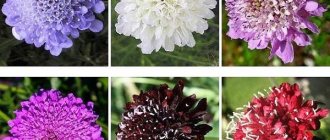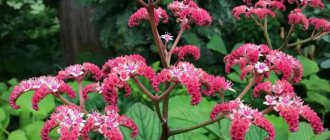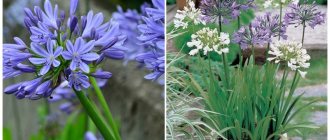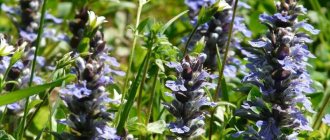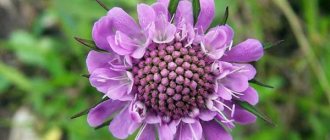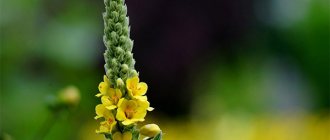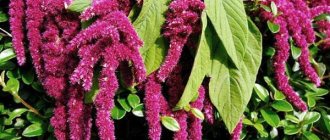Few plants that naturally live in the tropics can adapt to the conditions of the middle zone.
Such unpretentious ornamental crops include castor beans, planting and caring for them in open ground will not be difficult for even the most inexperienced summer resident. Having seen castor bean at least once, it is difficult to confuse it with any other large plant, with palmate leaves up to 80 cm in diameter and clusters of seed pods covered with thorns. The culture has an unassuming disposition and an enviable growth rate. Even in the middle zone, the height of castor beans can reach 3 meters. In more common climates, the castor bean is a perennial with seeds rich in castor oil. In summer cottages, the seed pods do not ripen, and the plant, called “castor beans” or “Christ palm,” is cultivated as an annual.
Features of castor beans
Castor bean is a bright representative of the Euphorbiaceae family. Its homeland is Africa. In the wild, the plant is found in the north and east of the continent. Castor beans began to be grown as a cultivated species starting in the second half of the 18th century. Then almost every garden in Britain was decorated with this flower. The plant was brought to Europe from India in the 19th century, where oils were obtained from it.
Blooming castor bean bush
Attention! In Russia, castor beans can only be grown as an annual plant.
Castor bean is the only representative of the species. It grows best in loose, sun-warmed and well-moistened soils with a high content of nutrients. The plant has a powerful stem and beautiful large leaves, the width of which reaches 80 cm. Most often they have a rich green color with prominent veins. The inflorescences resemble panicles and are densely arranged. After the castor bean, which does not require much effort to care for, has faded, oval-shaped fruits with thorns form on the stem. They are quite large in size.
Ripe fruits
Wintering, collecting seeds
Castor beans, regardless of the variety, in the climatic conditions of Russia are grown only as an annual crop, so replanting and preparation for wintering are not required. In autumn, after the onset of the first cold weather, the shoots begin to darken and the leaves quickly fade. A dried plant needs to be cut off at the very root, dug into the ground or thrown into a compost pit.
When growing castor beans in a sunny area, large seed pods have time to ripen before the onset of cold weather. The seed can be trimmed and placed in a dry, warm room. In this state, they need to be stored for 1-2 months (approximately until the beginning of December), after which the seeds should be removed and set aside for planting next season. Planting material remains viable for 3-4 years.
Classification of castor bean species
Castor bean (Ricinus communis)
Several types of castor bean are known. Most of them are completely different from each other. The most famous are:
- Borbonsky species. It has a red trunk, the structure is more like a tree with large glossy leaves.
- Zanzibar view. The trunk reaches two meters. It has huge dark red leaves.
- Indian or Cambodian species. Its height is only 1.2 m, which is small for a representative of such a family. The leaves are dark green in color.
- Gibson variety. The plant can grow up to one and a half meters. The leaves have a dark red color.
In Russia, the variety most often grown is “Kazachka”. It has a powerful stem and beautiful flowers. The plant blooms throughout August and September, but feels great until the first frost.
What kind of plant is this
This is an exotic, tree-like flower from the Euphorbia family. It is worth knowing that castor bean is a poisonous plant. Moreover, everything about this flower is poisonous, especially the seeds, which are very similar to beans.
Therefore, families with small children need to be extremely careful when growing such a flowerbed resident.
In general, if all precautions are taken, the plant is not fussy, easy to care for and very beautiful. Having planted it on the site, the yard will turn into a paradise with beautiful palm trees of different colors and sizes. After all, castor bean is very similar in appearance to a tropical palm tree.
In countries with warm climates, this bush is perennial. But here, we have to plant new seedlings every year and uproot them in the fall.
In nature, there are several varieties of castor beans. They vary in bush size and leaf color.
In its native environment, this bush grows up to ten meters. In our area, its average height is 1.5-3 meters. Sometimes there are five-meter specimens.
The color of the leaves can be lush green, brown, purple and blood red. Castor bean seed pods are similar to chestnuts, and depending on the variety, they also have different colors that last until late autumn.
Castor bean: growing from seeds, when to plant seedlings
Agapanthus: planting and care in open ground
Castor beans can grow from seeds that have fallen into the ground, but they can also be bred by growing seedlings. In central Russia, seeds begin to be prepared for planting in mid-April. In the southern regions this can be done a month later. To keep seedlings healthy, they need ten hours of daylight. This can be achieved with the help of additional lighting.
Before sowing, the seeds need to be treated to get rid of the thick shell, which makes it difficult for the sprout to emerge. Scarification is carried out using sandpaper. The surface of each seed is treated with it. After the procedure, the germination process will accelerate several times. After processing, the seed material is soaked in a growth-stimulating composition or ordinary water for a day.
Castor bean seeds
Plastic containers are used for planting. They are filled halfway with nutrient soil. Then the seeds are spread over the surface, pressing 20–30 mm. Scarified castor bean seeds sprout on the third or fourth day.
Home seedlings develop very actively. After the first leaves appear, it is necessary to move the containers to a cooler but well-lit place.
Attention! The room temperature should not be lower than 15 °C.
As the flower grows, the container is filled with additional soil. This is done until it is completely filled. If castor bean, which is quite simple to plant and care for, develops too quickly, it requires an additional transplant into a more spacious pot. The size of the sprouts before planting in the ground should not exceed 100 cm in height. When the threat of night frosts has passed, the plants are planted outside. To reduce the likelihood of injury to the root system, it is better to do this with a lump of earth.
Picking up seedlings
How to care for castor seedlings
Lighting is one of the important elements of caring for sprouts: it is necessary at all stages, because the plant comes from Africa, where there is a lot of sunlight.
Maintain humidity and temperature at 20-22 degrees until the first leaves appear - after which it is necessary to move to a cooler place (15-17 degrees). This will help avoid the greenhouse effect and stretching of seedlings.
Regular watering for sprouts is mandatory; you can fertilize them with various mineral complexes containing macro- and microelements:
- nitrogen;
- potassium;
- phosphorus;
- zinc;
- iron;
- boron
To combat pests, the soil used for planting should be calcined in the oven at a temperature of 200 degrees to remove pathogenic organisms and harmful larvae.
If you have a steamer on hand, you can steam the substrate for disinfection (duration 1.5 hours). To care for the soil, it is worth doing thinning. Of the 2-3 sprouts, the strongest specimen is left, without violating the integrity of its root system. Using nail scissors, remove weakened shoots at the substrate level.
If the soil settles, you need to add it, this will strengthen the stem and root system of the seedling.
A few recommendations:
- If the seeds still stretch out, then you need to add a substrate. 14 days before planting in the ground, the seedlings must be hardened to prepare the exotic crop for sunlight.
- If there is a shell left on the cotyledon leaves, you need to cut it with small scissors and carefully remove it with a toothpick without damaging the sprout.
- If the seedling growth rate is high, it must be transplanted into a larger container.
After 4-5 days, sprouts appear; here it is necessary to lower the temperature to avoid stretching
Features of garden care
Proper care of castor beans consists of several procedures. Watering should be plentiful (a bucket of water per bush), but not too frequent (once a week). The place where the plant is located should be sunny and protected from the wind.
Important! In some cases, the plant trunk is tied to a support.
When deciding what to feed castor beans for rapid growth, you need to take into account its size and needs. The plant responds well to nitrogen compounds. It is better to start fertilizing a couple of weeks after planting in the ground. The soil in which castor beans will grow, when to plant which, you can find out on the Internet, must be nutritious.
You cannot sow crops where there are children and animals. This is a fatal risk for people who are hypersensitive to such plants. Even if you use gloves, you should wash your hands with soap after handling the flower.
Important! When choosing a place for the plant, it is worth remembering that castor beans are poisonous.
Planting in open ground
Young castor seedlings are planted in open ground when the spring frosts have passed (the second half of May). Before planting, you should dig the soil deeply and add plenty of fermented compost or granulated manure. On sandy soils, before planting castor beans, it is good to make large holes with compost and then plant seedlings in them.
In warmer regions, castor beans are planted in the ground with seeds. This is also practiced if there are no conditions for caring for seedlings at home. Seeds are sown in the second half of May directly into the ground, to a depth of 2 cm, no denser than every 70 cm. We dig a hole and plant 3 seeds. When shoots appear, we leave the strongest plant. Due to their tap root, which is easily damaged, these plants cannot tolerate transplantation, so they are sown immediately in a permanent place.
When and how does it bloom
The plant has rather small flowers collected in racemes. There are male and female inflorescences. The first ones have a pistil and are located at the top of the stem. The second ones have stamens, and they grow at the bottom. The fruits are hidden in the leaves and covered with thorns. The capsules are colored yellow, pink and purple, and the seeds are copper-colored with an original pattern of brown lines.
The plant is pollinated by the wind. This should be taken into account when deciding how and where to plant castor beans from seeds. Flowering begins in late July or early May and can continue until the cold weather. Blooming castor beans literally transform the area.
Decoration of the site
Diseases and pests
Spider mite
Diseases and pests are what interfere with the full development of any flower. Castor beans are resistant to various diseases and insects. Still, sometimes its root system begins to rot. This occurs due to stagnation of moisture. Fungal diseases can also rarely occur.
Mites and aphids are the most common pests that can attack plant parts. It is recommended to get rid of them using special preparations or a solution of laundry soap.
To prevent any diseases and pests from destroying the bush, you should know the rules of prevention. You should not plant a palm tree on one or many times. It is recommended to collect seeds only from bare areas of the ground. Only those varieties that are resistant to diseases are selected for propagation.
If all the recommendations are followed, then there is no need to be afraid of the plant becoming infected. It is easier to take care of prevention in advance than to spend a lot of time and effort on treatment later.
Care after flowering
Castor beans cannot survive severe frosts, so they have to be replanted next year.
Before the onset of winter, some gardeners collect castor bean seeds for planting. This is done at the end of November. However, the seeds do not always fully ripen. It is much easier to buy them in a seed store, where they sell already selected material with good germination. Seeds collected on your own can be stored for no more than four years.
To obtain seed material, you need:
- Select the fluffiest inflorescence by removing the remaining flower stalks from the stem.
- Carefully pick and split the grown and dried fruits.
- Dry the resulting seeds for several weeks and pour them into canvas bags for storage. When winter passes, they can be grown into seedlings.
Important! The seeds are no less poisonous than the plant itself, so they must be kept away from children and animals.
Preparing for landing
A week before planting castor beans, the area must be carefully dug to a depth of at least 1 shovel, stones, plant debris and roots must be removed. It is recommended to fertilize the area with organic matter, for example, mullein solution at the rate of 2 liters of product per meter. Additionally, you can add nitroammophoska in a volume of 10-15 g per m2.
Castor bean seeds have good germination, but it is recommended to prepare them before planting. First, they need to be scarified - slightly damage the skin by any mechanical means, and then immerse in a solution of a growth stimulator (Epin or Kornevin) for 10-13 hours. If the stimulator is not available, the planting material can simply be wrapped in a damp cloth or napkin and then stored in a warm place for 24 hours.
Possible problems in growing
Castor beans rarely need chemical treatments, as they can cope with most pests on their own. However, the bush is not protected from diseases. The most dangerous for the plant are:
- powdery mildew;
- gray rot;
- late blight
- bacteriosis
To treat and prevent these diseases, plantings are treated with fungicides or Bordeaux mixture.
Of the pests, the most dangerous are moth caterpillars; wireworm; sand slugger and bugs. To protect young shoots, after planting in the ground, they are treated with potassium permanganate in a weak solution or spices are planted nearby that repel harmful insects.
You need to know all this to understand why castor beans grow poorly in the garden.
Selection of location and conditions of detention
Castor bean is unpretentious; rapid plant growth is possible even in unfavorable climates. Before planting, it is important to choose the right place, since the richness of the color of the leaves, branches and flowers, as well as the decorativeness of the shrub on the site, depends on this.
Lighting and location
To plant the plant, you need to choose a well-lit place with long daylight hours. It is not recommended to plant castor beans in partial shade or complete darkness, where the bush grows slowly and the color of the vegetative parts will be faded.
The place must be protected from strong gusts of wind and drafts. The plant can be planted next to buildings or fences. Castor beans are suitable for solitary (single) planting and look good in a group of one or several varieties.
Temperature
Castor bean is not sensitive to temperature conditions and can grow and develop in almost any climate. Heat directly affects the growth rate and volume of foliage. The minimum threshold for the active development of young plants is 15-18°C; in colder conditions, the plant develops slowly and may die. At temperatures in the range of 18-25°C, the maximum growth rate is observed. Castor oil does not tolerate sudden changes in temperature, has poor frost resistance and does not survive night frosts.
Air and humidity
The plant belongs to tropical crops; high soil moisture is required for harmonious development and rapid growth. It needs to be maintained with regular watering, spraying and mulching. The minimum soil moisture is 75-80%; during drought, the leaves begin to deform and look weak and faded.
Castor oil does not tolerate drafts and strong winds. When planting in an open area, it is advisable to provide additional support. It is best to plant the plant next to a structure or a fence to reduce the harmful effects of wind.
Priming
The soil for planting castor beans must be fertile and nutritious; it is recommended to plant the plant only in black soil. The shrub feels best in loose and aerated substrates with a neutral or slightly acidic reaction. The area should hold water well, but not be waterlogged. Planting in lowlands, sandy and clay soils should be avoided.
The benefits and harms of castor beans
The beneficial and harmful properties of the plant are determined by its chemical composition. The plant contains fatty acids that are necessary for the body, and ricin, which is dangerous for people and animals. When processed in production, all toxic substances disappear, but the risk of negative effects is possible if the final product is used uncontrolled.
The well-known castor oil is made from castor beans, which effectively cleanses the intestines and, when taken correctly, is completely safe even for children. Sometimes castor oil is used to stimulate labor during prolonged labor. Any use of medicines containing castor beans must be agreed with a doctor.
Interesting! Castor bean is contained in Vishnevsky ointment and some other medications. They are completely non-toxic and are dangerous only for people with hypersensitivity to individual components of the substance.
The plant is also widely used in cosmetology. It helps with the following problems:
- brittleness and dryness of hair;
- dandruff;
- slow growth and loss of eyelashes;
- pimples and black spots on the skin.
The plant contains poison that can harm humans and animals. That is why you should not touch castor beans without gloves and after contact you should immediately wash your hands and face. At the first signs of poisoning, you should empty your stomach with a tube or induce vomiting, take activated charcoal and wait for emergency doctors. In people with hypersensitivity to castor bean components, its use causes an allergic attack.
Use in medicine and cosmetology
The beauty and unusualness of castor beans makes it popular among gardeners all over the world. The plant has a number of beneficial properties. But do not forget about the poisonousness of the flower and the caution that must be observed when growing it.
Use in landscape design
The castor plant is very similar to a palm tree and looks exotic, so it is of great interest to landscape designers. The shrub can be planted either in composition with other shrubs or alone. It can also be grown in beautiful flowerpots. Also, in some cases, castor beans are planted as a hedge. This really attracts the attention of passersby.
Most often they choose a place close to home. Palm trees are also planted near gazebos. It also looks beautiful in combination with other, smaller plants.
